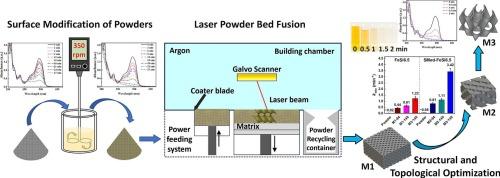Surface modification of FeSi6.5 powders for additively manufactured catalysts with enhanced azo dye degradation
IF 6.7
2区 工程技术
Q1 ENGINEERING, CHEMICAL
引用次数: 0
Abstract
Developing efficient and scalable catalysts for wastewater treatment remains challenging due to the limited activity of crystalline alloys and fabrication constraints of amorphous alloys. Here, a novel hybrid additive manufacturing strategy is proposed, integrating powder surface modification (PSM) with laser powder bed fusion (LPBF) to enhance the catalytic performance of Fe![]() Si alloys. This strategy produces TPMS architectures with enlarged surface area and pure Fe beads, which synergistically enhance Fenton-like reactions for azo dye degradation. Using acid orange 7 (AO7) as a model pollutant, PSM-LPBF-fabricated FeSi6.5 achieved complete decolorization within 2 min with a degradation rate constant of 3.42 ± 0.26 min−1, which is more than twice that of counterparts fabricated from FeSi6.5 powders without PSM. This study highlights a cost-effective strategy with strong potential for scalable azo dye degradation applications.
Si alloys. This strategy produces TPMS architectures with enlarged surface area and pure Fe beads, which synergistically enhance Fenton-like reactions for azo dye degradation. Using acid orange 7 (AO7) as a model pollutant, PSM-LPBF-fabricated FeSi6.5 achieved complete decolorization within 2 min with a degradation rate constant of 3.42 ± 0.26 min−1, which is more than twice that of counterparts fabricated from FeSi6.5 powders without PSM. This study highlights a cost-effective strategy with strong potential for scalable azo dye degradation applications.

FeSi6.5粉末的表面改性及其对偶氮染料的增强降解作用
由于晶体合金的活性有限和非晶合金的制造限制,开发高效和可扩展的废水处理催化剂仍然具有挑战性。本文提出了一种新的混合增材制造策略,将粉末表面改性(PSM)与激光粉末床熔合(LPBF)相结合,以提高FeSi合金的催化性能。这种策略产生了具有更大表面积和纯铁珠的TPMS结构,协同增强了偶氮染料降解的类芬顿反应。以酸性橙7 (AO7)为模型污染物,PSM- lpbf制备的FeSi6.5在2 min内实现了完全脱色,降解速率常数为3.42±0.26 min−1,是无PSM制备的FeSi6.5粉末的2倍以上。这项研究强调了一种具有成本效益的策略,具有可扩展的偶氮染料降解应用的强大潜力。
本文章由计算机程序翻译,如有差异,请以英文原文为准。
求助全文
约1分钟内获得全文
求助全文
来源期刊

Journal of water process engineering
Biochemistry, Genetics and Molecular Biology-Biotechnology
CiteScore
10.70
自引率
8.60%
发文量
846
审稿时长
24 days
期刊介绍:
The Journal of Water Process Engineering aims to publish refereed, high-quality research papers with significant novelty and impact in all areas of the engineering of water and wastewater processing . Papers on advanced and novel treatment processes and technologies are particularly welcome. The Journal considers papers in areas such as nanotechnology and biotechnology applications in water, novel oxidation and separation processes, membrane processes (except those for desalination) , catalytic processes for the removal of water contaminants, sustainable processes, water reuse and recycling, water use and wastewater minimization, integrated/hybrid technology, process modeling of water treatment and novel treatment processes. Submissions on the subject of adsorbents, including standard measurements of adsorption kinetics and equilibrium will only be considered if there is a genuine case for novelty and contribution, for example highly novel, sustainable adsorbents and their use: papers on activated carbon-type materials derived from natural matter, or surfactant-modified clays and related minerals, would not fulfil this criterion. The Journal particularly welcomes contributions involving environmentally, economically and socially sustainable technology for water treatment, including those which are energy-efficient, with minimal or no chemical consumption, and capable of water recycling and reuse that minimizes the direct disposal of wastewater to the aquatic environment. Papers that describe novel ideas for solving issues related to water quality and availability are also welcome, as are those that show the transfer of techniques from other disciplines. The Journal will consider papers dealing with processes for various water matrices including drinking water (except desalination), domestic, urban and industrial wastewaters, in addition to their residues. It is expected that the journal will be of particular relevance to chemical and process engineers working in the field. The Journal welcomes Full Text papers, Short Communications, State-of-the-Art Reviews and Letters to Editors and Case Studies
 求助内容:
求助内容: 应助结果提醒方式:
应助结果提醒方式:


